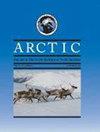Population Characteristics, Morphometry, and Growth of Harvested Gray Wolves and Coyotes in Alaska
IF 0.8
4区 地球科学
Q4 ENVIRONMENTAL SCIENCES
引用次数: 1
Abstract
Few concurrent studies exist of sympatric gray wolf (Canis lupus) and coyote (C. latrans) harvest at far northern latitudes. Moreover, no studies explicitly examine effects of concurrent harvest on phenotypes of wolves and coyotes. We documented changes in sex and age characteristics and morphology of gray wolves and coyotes harvested by hunters near Ptarmigan Lake, east-central Alaska, USA, between 1998 and 2001. We hypothesized that the harvest would result in larger, heavier canids, reduce densities, and increase young to adult ratios in both wolves and coyotes. We generated von Bertalanffy growth curves indicating that wolves and coyotes of both sexes increased in length or weight until 2 or 3 years old. No significant changes in either mean length or weight or length to weight ratios occurred during the 3-year study, except that coyote mean length was longer over the last winter of study. Catch-per-unit effort (CPUE) for wolves ranged from 0.061 to 0.112 killed/day and for coyotes from 0.552 to 0.11 killed/day over the study. CPUE indicated that coyotes but not wolves declined in abundance. Changes in male to female and young to adult ratios did not differ significantly for either canid. We posit that coyote populations were disproportionately affected by the conflation of the severe Arctic environment and sustained harvest. Our findings will be beneficial for managing sympatric canid populations and for understanding demographic responses to density-dependent processes in wolves and coyotes, especially at far northern latitudes.阿拉斯加灰狼和土狼的种群特征、形态和生长
在远北纬地区,对同域灰狼(Canis lupus)和土狼(C. latrans)收获的研究很少。此外,没有研究明确检查同时收获对狼和土狼表型的影响。我们记录了1998年至2001年间美国阿拉斯加州中东部雷鸟湖附近猎人捕获的灰狼和土狼的性别、年龄特征和形态变化。我们假设,收获会导致更大、更重的犬科动物,降低密度,并增加狼和土狼的幼崽与成年狼的比例。我们生成了von Bertalanffy生长曲线,表明狼和土狼在2岁或3岁之前的长度或体重都在增加。在为期3年的研究中,除了土狼的平均长度在研究的最后一个冬天更长之外,平均长度或体重或长重比都没有发生显着变化。在研究中,狼的单位捕获量(CPUE)从0.061到0.112只/天不等,土狼的单位捕获量从0.552到0.11只/天不等。CPUE表明,土狼的数量减少,而狼的数量没有减少。在两种犬科动物中,雄犬对雌犬和幼犬对成年犬的比例变化没有显著差异。我们假设土狼的数量不成比例地受到了北极恶劣环境和持续收获的双重影响。我们的研究结果将有助于管理同域犬科动物种群,并有助于理解狼和土狼对密度依赖过程的人口反应,特别是在远北纬地区。
本文章由计算机程序翻译,如有差异,请以英文原文为准。
求助全文
约1分钟内获得全文
求助全文
来源期刊

Arctic
地学-环境科学
CiteScore
2.30
自引率
0.00%
发文量
51
审稿时长
6-12 weeks
期刊介绍:
Arctic is a peer-reviewed, primary research journal that publishes the results of scientific research
from all areas of Arctic scholarship. Original scholarly papers in the physical, social, and biological
sciences, humanities, engineering, and technology are included, as are book reviews,
commentaries, letters to the editor, and profiles of significant people, places, or events of northern
interest
 求助内容:
求助内容: 应助结果提醒方式:
应助结果提醒方式:


